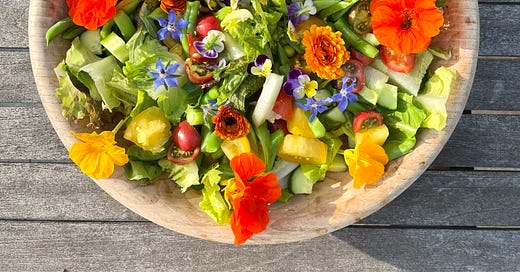Summer salad and flowers, grown in the garden!
The Flavour Myth
How Big Food Made Us Think Healthy Tastes Bad
Last week, I attended an event in London with Dan Kittredge, founder of the Bionutrient Institute. He made a point that really stuck with me:
"Kids don’t like fruit and veg, because they know it’s crap."
And I agree with him. The animal instinct in us knows. If the veg tastes good, the kids will eat it.
Dan’s research explores what makes a crop truly nutritious. His findings suggest that the key to nutrient density is the microbial life in the soil—and that taste is one of the best ways to tell if your food is actually nourishing.
I know this from experience. When I switched to eating organic food, I realised I no longer needed to drown my vegetables in sauces or cheese to enjoy them. With just a little oil and seasoning, they were naturally delicious.
Before this, I often bought supermarket vegetables or salad bags, only to throw them away because they were lifeless and tasteless.
At the time, I couldn’t understand why I didn’t like vegetables that much anymore.
But the problem wasn’t me—it was the food and the soil it came from.
Why Is Some Veg Tasteless?
The answer lies in how it’s grown.
For most of human history, food was grown in rich, biodiverse soil—teeming with microbes, minerals, and the intelligence of nature. But in the past century, our food system has become obsessed with efficiency over flavour.
After the Second World War, food security became a national priority, leading to a widespread shift to industrial farming, using synthetic fertilisers and pesticides.
Now, over 90% of UK food is sold through just nine major retailers. That gives them immense power in the supply chain, and means most of our food comes from a system that prioritises yield and profit over flavour and nutrition.
Scientific research confirms that industrial farming has reduced both the taste and nutritional quality of our food. Studies suggest that mineral, vitamin, and protein content in vegetables has declined by 5% to 40% or more over the past 60 years.
👉 Source: Horticultural Science Journal
But the decline in flavour is about more than lost nutrients—it’s about a lost relationship with the land itself.
The Link Between Soil, Nutrition, and Taste
Soil isn’t dirt—it’s a living, breathing intelligence.
Matthew Adams, co-founder of Growing Real Food for Nutrition (GRFFN), has been researching how soil health affects food quality. His Food Quality First report challenges the idea that nutrition is just about nutrient density. Instead, it highlights nutrient variation—how soil life, plant diversity, and farming methods shape the nutritional makeup of food.
👉 Source: GRFFN
Simply put: flavour and nutrition come from the vitality of the soil.
In nature, animals instinctively select the most nutrient-rich food. They don’t need a label that says organic or high in iron—they just know.
Humans have this ability too—but we’ve largely forgotten it.
The rise of synthetic inputs, mass farming, and ultra-processed foods has dulled our senses. We’ve forgotten what real food tastes like.
GRFFN’s research suggests that taste testing could be one of the most powerful tools for identifying nutritious food—helping us relearn how to listen to the land through our own bodies.
Why Organic Food Often Tastes Better
Organic vegetables often have more flavour because they have to work harder to grow.
Under Soil Association organic standards, synthetic fertilisers and pesticides are banned. Instead, organic farmers build soil fertility naturally—using compost, green manure, seaweed, and minerals from the earth itself.
Because organic plants cannot rely on synthetic help, they develop deeper roots, absorb more nutrients, and build stronger, richer flavours.
Meanwhile, conventionally grown crops are often fed artificial fertilisers, growing fast but shallow—leading to weaker flavour and nutrition.
The Rise of Ultra-Processed Food
While real food got weaker, Ultra-Processed Foods (UPFs) got stronger—engineered for maximum cravings.
💡 UPFs are formulated with the ideal mix of sugar, fat, and salt to keep us coming back for more.
👉 Source: BMJ Study on Ultra-Processed Food and Overeating
And it’s no accident that the cheapest, easiest-to-access food is also the most processed. The way the food system is structured makes ultra-processed food the default choice—while real food becomes harder to access.
Flavour is a Way Back to What’s Real
When you eat food that’s truly alive, you feel more alive too.
Flavour isn’t just taste—it’s a message from the land. It’s how nature speaks to us, saying:
"This is real. This is alive. This is what you need."
And here’s something else Dan Kittredge touched on at the event:
When a crop struggles with pests, it’s a sign that something is off balance.
Rather than seeing pests as a problem to be eliminated, nature sees them as a signal—an indicator that the plant lacks resilience, often due to poor soil health. Instead of listening, we intervene with pesticides, suppressing the symptom rather than addressing the root cause.
But when farmers work with nature rather than against it, something shifts. Healthier soil leads to stronger plants, better flavour, and fewer so-called "pests"—because balance is restored.
It’s not about controlling nature—it’s about learning from it.
What Can We Do?
💚 Trust your taste buds—flavour is nature’s way of guiding you.
💚 If you can, support farmers who grow with nature, not chemicals.
💚 Grow something yourself—even if it’s just herbs on a windowsill.
💚 Cook from scratch when you can.
Every time we choose food that is truly alive, we push back.
Every time we reclaim flavour and nutritious food, we reclaim a piece of ourselves.
👉 Have you noticed a difference in how food tastes? What’s your go-to way of finding real flavour? Drop a comment—I’d love to hear…
Thanks for reading Fields of Imagination! This post is public so feel free to share it.






Love this :) xx